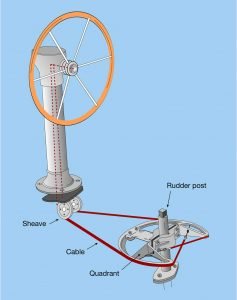Take a look around the average boatyard and you will see examples of all kinds of different rudders and steering systems. Some rudders hang off the transom, some hang beneath the stern, others are built into the back of the keel, some look fine and elegant, others are crude and square – there really are all sorts.
One thing all rudders have in common is that they have three main parts that need to be checked: the rudder, or a steerable drive leg in the case of many power boats; the system that joins the rudder to the steering; the steering control itself.
Transom hung rudder
Traditional, aft hung rudders with tiller steering are the simplest form of rudder. A common form is the 3-point hung type with a laminated tiller attached through a hole in the top of the rudder. Fixed to the transom there are usually two or three metal eyes or gudgeons (made from bronze or stainless steel), through which metal pintles, with tangs attached to the rudder, slot into place. This forms a hinge. At the base of the rudder is a heel bearing which helps support the rudder.There are different ways for the rudder to be connected to the transom and also to the keel, depending on keel type. Some tillers are attached to the head of the rudder stock by metal straps.
Transom hung rudder checks:
- Check whether the pintles and gudgeons are worn and how much play there is in the rudder as a result, by moving it from side to side and up and down. The pintles and gudgeons should be replaced if there is excessive wear – 2-3 mm is about the limit.
- Check for loose fastenings. If these are found inspect wooden rudders or transoms for signs of rot.
- Inspect stainless steel gudgeons and pintles for signs of corrosion. Be prepared to remove the rudder in order to make a full inspection.
- Check the pivot bolt for wear.
Skeg rudder
A skeg rudder is a variation of the transom hung rudder used by boats without a full length keel. The skeg hangs down below the hull in place of the keel, providing support and protection for the rudder. A full-skeg hangs down the full length of the rudder, while a half-skeg supports the upper part of the rudder only.
Skeg rudder checks:
- As with all types of rudder, if there is a distinct vibration in the tiller when sailing, this indicates bearing failure.
- Check all the pivot points for wear.
- Check the condition of the skeg, as skegs are subjected to very large stresses at sea. Check the seam is not cracked and the laminate waterlogged as a result.
- The bottom bearing of a skeg-hung rudder is usually very reliable but if there is excessive play then this will need replacing.
Galvanic corrosion
Rudders, rudder fittings and stern drives are at risk of galvanic corrosion. If your boat’s rudder is made of metal it will most likely have a sacrificial anode bolted to it. This will need replacing when more than half of the anode has been lost to corrosion. Points worth remembering are:
- Anodes will not work if they are painted over.
- Make sure the metal is bare beneath the anode.
- For outdrives, check your engine manual to be sure how many anodes you need and where they should go.
Preventative maintenance
Preventative maintenance is especially important for rudders. However, the annual maintenance of a rudder and steering system should be approached with some caution as there are not really any hard and fast rules that apply to all. It is always best to follow manufacturer’s recommendations. However, if you are unable to access this information or are unsure how best to proceed, then check with your boatyard or surveyor to find out precisely what needs to be done before going into DIY mode.
Take rudder bearings for example – some should never be greased, others require special synthetic grease. Roller bearings and seals should be replaced on a regular basis, normally every five years, according to manufacturer’s recommendations.
It is good practice to remove a rudder for a thorough inspection every four or five years and certainly before a long offshore voyage.
Wheel steering systems
Wheel steering systems include cable operated types, push-rod and hydraulic systems. Here are some of the usual checks, but for all the specific requirements for your boat, refer to the manual:
- Check cables for broken strands, which will need to be replaced if found.
- Check and adjust cable tension if necessary, being careful not to over tighten.
- Check all pivots, connections, split pins and adjusters.
- Check the condition and tightness of bearings at the end of push-rods.
- Check the fluid level in the reservoir of hydraulic systems and check for leaks.
- Check all pivots for wear and all steering locking devices.











